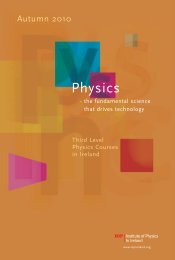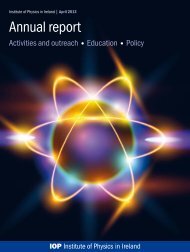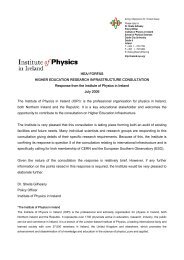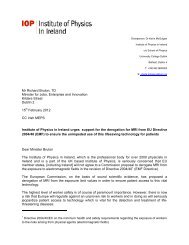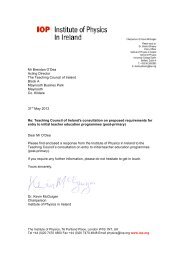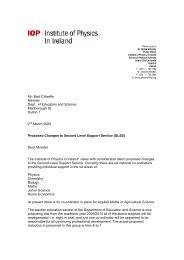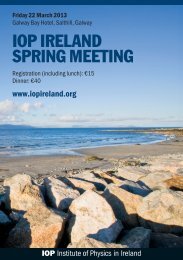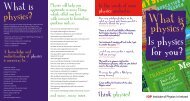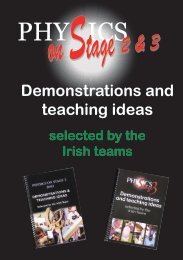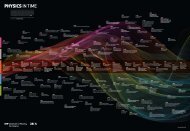28 Days 28 Physicists - The Institute of Physics in Ireland
28 Days 28 Physicists - The Institute of Physics in Ireland
28 Days 28 Physicists - The Institute of Physics in Ireland
You also want an ePaper? Increase the reach of your titles
YUMPU automatically turns print PDFs into web optimized ePapers that Google loves.
A day <strong>in</strong> the life <strong>of</strong> a <strong>Physics</strong> Lecturer<br />
First job <strong>of</strong> the day – ensure I am <strong>in</strong> the right place! I work both as a lecturer <strong>in</strong> the <strong>Physics</strong> Department at<br />
University College Cork and conduct research <strong>in</strong> the Photonics Centre at Tyndall National <strong>Institute</strong> - juggl<strong>in</strong>g two<br />
locations takes a lot <strong>of</strong> forward plann<strong>in</strong>g.<br />
Most days, I concentrate on teach<strong>in</strong>g activities <strong>in</strong> the morn<strong>in</strong>g and then head to Tyndall <strong>in</strong> the afternoon to meet<br />
with my team <strong>of</strong> researchers that makes up the Quantum Optics Group. This morn<strong>in</strong>g I am with a large group <strong>of</strong><br />
budd<strong>in</strong>g eng<strong>in</strong>eers giv<strong>in</strong>g a lecture on mechanics.<br />
All our f<strong>in</strong>al year students conduct research projects as part <strong>of</strong> their degree programme. Today, after the lectures,<br />
I spend a couple <strong>of</strong> hours help<strong>in</strong>g to br<strong>in</strong>g together compatible students, projects and supervisors. <strong>The</strong> match is<br />
important to make sure that the student has an enjoyable experience, learn<strong>in</strong>g new skills that he or she will use <strong>in</strong><br />
the workplace or if they choose to study for a higher degree such as an MSc or PhD.<br />
Once teach<strong>in</strong>g is over, I head to the research laboratory to see how th<strong>in</strong>gs are go<strong>in</strong>g there.<br />
<strong>The</strong> lab is a hive <strong>of</strong> activity with a number <strong>of</strong> experiments runn<strong>in</strong>g. In one experiment we have a really complex<br />
optical and vacuum setup where we cool rubidium atoms down to 50 microKelv<strong>in</strong> us<strong>in</strong>g a technique known as<br />
laser cool<strong>in</strong>g. This allows us to study the quantum nature <strong>of</strong> atoms - a very hot topic <strong>in</strong> physics as a<br />
quantum revolution is tak<strong>in</strong>g place. Tried and tested theories are now be<strong>in</strong>g used to realise a<br />
host <strong>of</strong> quantum-based technologies such as comput<strong>in</strong>g, sens<strong>in</strong>g and <strong>in</strong>formation security.<br />
<strong>The</strong>re’s so much <strong>in</strong>strumentation be<strong>in</strong>g used for the laser-cool<strong>in</strong>g setup that it is quite<br />
daunt<strong>in</strong>g and a real challenge to master. We use a very expensive and delicate <strong>in</strong>frared<br />
laser system for this experiment: the laser beam consists <strong>of</strong> a stream <strong>of</strong> light<br />
particles known as photons. We sh<strong>in</strong>e the laser onto rubidium atoms and, on<br />
collision, each photon removes some energy from each atom. This slows each<br />
atom down, thereby reduc<strong>in</strong>g the average temperature <strong>of</strong> the atoms.<br />
In another experiment we explore novel types <strong>of</strong> laser systems, known<br />
as microlasers due to their size. <strong>The</strong> microlasers we use are about the<br />
size <strong>of</strong> a speck <strong>of</strong> dust and can <strong>of</strong>ten be confused with just that! When<br />
work<strong>in</strong>g, they emit bright green light because <strong>of</strong> the materials they<br />
are made <strong>of</strong> (glass doped with erbium ions). <strong>The</strong>se microlasers can<br />
be used for a lot <strong>of</strong> different purposes and need to be pumped<br />
optically <strong>in</strong> order to emit the green light. One excit<strong>in</strong>g use <strong>of</strong> these<br />
lasers is as m<strong>in</strong>iature mechanical systems for switch<strong>in</strong>g devices<br />
<strong>in</strong> optical circuits. To make the microlasers we sh<strong>in</strong>e light from<br />
a very powerful CO 2<br />
laser onto some glass powder to melt it<br />
– when the CO 2<br />
laser is on we have to be very careful s<strong>in</strong>ce<br />
it could immediately burn a hole <strong>in</strong> human flesh or cause<br />
bl<strong>in</strong>dness.<br />
I need to organise a trip for myself and one <strong>of</strong> my<br />
research students to visit our collaborators <strong>in</strong> Germany<br />
and Austria next month. <strong>The</strong> research group meet to<br />
discuss who should travel and the benefits to the<br />
people <strong>in</strong>volved- there are usually more volunteers<br />
than places so this is a tough decision to make.<br />
At 4pm I’m <strong>of</strong>f to meet a visit<strong>in</strong>g US pr<strong>of</strong>essor<br />
who is giv<strong>in</strong>g a talk on “50 Years <strong>of</strong> the LASER”<br />
to celebrate the laser’s historic birthday s<strong>in</strong>ce<br />
it first come <strong>in</strong>to operation <strong>in</strong> 1960. This is<br />
part <strong>of</strong> a series <strong>of</strong> sem<strong>in</strong>ars for all the staff<br />
and students, which I organise, so I’m<br />
delighted to see a good turn out.<br />
7pm and time to leave. I list all the jobs<br />
to be tackled tomorrow and send<br />
e-mails to the researchers to make<br />
sure they know what to do. Another<br />
work day is over and I’m <strong>of</strong>f to the<br />
gym to relax.<br />
Síle Nic Chormaic<br />
<strong>Institute</strong> <strong>of</strong> <strong>Physics</strong> <strong>in</strong> <strong>Ireland</strong> www.iopireland.org<br />
‘we cool<br />
rubidium<br />
atoms down to 50<br />
microKelv<strong>in</strong> us<strong>in</strong>g a<br />
technique known as<br />
laser cool<strong>in</strong>g.’<br />
Physicist Síle Nic Chormaic attend<strong>in</strong>g an atomic<br />
physics conference <strong>in</strong> Australia. Síle has a BSc <strong>in</strong><br />
Experimental and Mathematical <strong>Physics</strong> from NUI<br />
Maynooth. She then ga<strong>in</strong>ed an MSc <strong>in</strong> atomic physics<br />
from Maynooth and a PhD <strong>in</strong> atom optics from<br />
Université Paris-Nord.<br />
19<br />
Discover Science and Eng<strong>in</strong>eer<strong>in</strong>g www.science.ie



